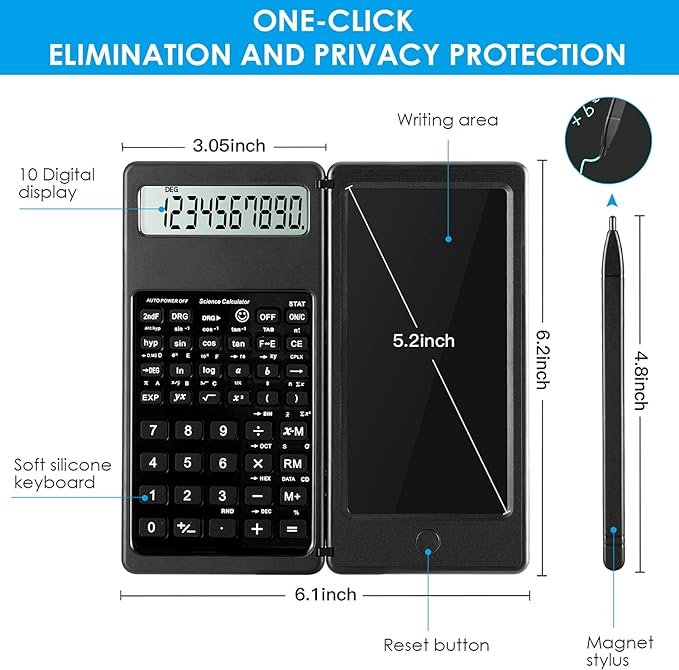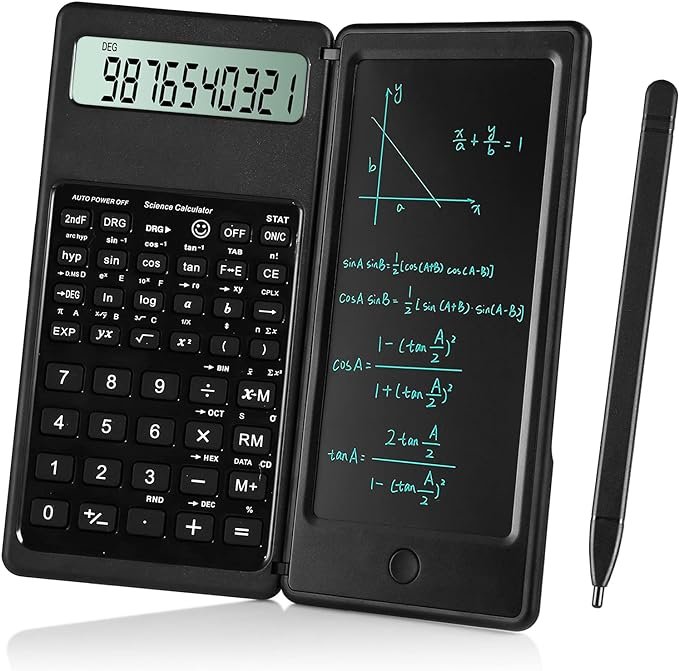Why Every Student Needs a Scientific Calculator
Scientific calculators have become an indispensable tool for middle and high school students. Their importance extends beyond basic arithmetic, offering a wide array of functions that support students in understanding and solving complex mathematical concepts.
At the core of mathematics education in middle and high school are subjects like geometry, algebra, and calculus. A scientific calculator simplifies these subjects by providing functions that assist with everything from solving quadratic equations to performing trigonometric calculations. This not only aids in computations but also helps students visualize and internalize mathematical principles more effectively.
Moreover, scientific calculators are vital for preparing students for standardized tests and exams. These assessments often include advanced mathematical reasoning that exceeds the basic capabilities of regular calculators. With a scientific calculator, students can tackle these challenges more effectively, enhancing their chances of performing well on these crucial tests.
The role of scientific calculators in enhancing problem-solving skills cannot be overstated. They allow students to explore various approaches to solving a problem, thereby nurturing critical thinking and analytical abilities. These calculators are also instrumental in reducing calculation errors, which can be particularly beneficial during exams when accuracy is paramount. By minimizing errors, students can focus more on the conceptual understanding of the problems at hand, leading to better academic performance and increased confidence.
In conclusion, the integration of scientific calculators into the classroom environment is a necessity for middle and high school education. These devices not only support students in mastering complex mathematical topics but also play a crucial role in preparing them for standardized tests, enhancing their problem-solving capabilities, and boosting overall academic confidence.
Key Features of Modern Scientific Calculators

Modern scientific calculators have evolved significantly, becoming essential tools for students in both middle and high school. One of the standout features of these calculators is the 10-digit large screen, which offers enhanced readability. This large display facilitates the clear presentation of complex equations and computations, enabling students to accurately interpret results during classroom activities and exams.
Advanced functions are another hallmark of contemporary scientific calculators. These devices come equipped with a variety of mathematical operations including trigonometric, logarithmic, and statistical computations. These functions are crucial for high school students tackling subjects such as algebra, calculus, and physics. The inclusion of these advanced capabilities ensures that the calculator can handle a diverse array of mathematical problems, making it an invaluable tool throughout a student’s academic journey.
Ergonomic design is also a significant consideration in the development of modern scientific calculators. These calculators are crafted to be comfortable for extended use, reducing strain on the user’s hands and wrists. This ergonomic focus is particularly beneficial during prolonged study sessions or lengthy examination periods, ensuring that students maintain efficiency and comfort.
Another innovative feature found in some modern scientific calculators is the built-in notepad. This functionality allows students to jot down quick notes and intermediate calculations directly on the device. This feature can be particularly advantageous in classroom settings, where students can swiftly record their thought processes and intermediate steps without having to transition between different tools. The integrated notepad thus enhances the overall efficiency and effectiveness of the calculator as an educational aid.
In summary, the combination of a large, readable screen, advanced mathematical functions, ergonomic design, and an integrated notepad makes modern scientific calculators indispensable for students. These features support a wide range of academic activities, from daily classroom exercises to rigorous exam preparations, thereby solidifying their place as essential tools in the educational journey of middle and high school students.
Top Scientific Calculators for Students: Our Recommendations

When it comes to equipping students for their academic journey, a reliable scientific calculator is indispensable. Among the vast array of options available, certain models stand out for their unique features, user-friendly interface, and durability. Below, we review some of the top scientific calculators that are ideal for both middle and high school classrooms.
Texas Instruments TI-30X IIS
Renowned for its reliability, the Texas Instruments TI-30X IIS is a favorite among students and teachers alike. This calculator boasts a dual-line display, which allows for easy viewing of complex calculations and corrections. Priced at around $45, it offers solid functionality at an affordable rate. Students appreciate its ease of use, while teachers commend its durability and long battery life.
Casio FX-115ES PLUS
The Casio FX-115ES PLUS is celebrated for its flexibility and advanced capabilities. With over 280 functions, it covers a broad spectrum of subjects from algebra to chemistry. Its natural textbook display is particularly useful for students as it mirrors the way formulas and equations appear in textbooks. Priced at approximately $10, it offers exceptional value for its extensive feature set. Users often highlight its intuitive interface and solar-powered option as major benefits.
Sharp EL-W516TBSL
Next on the list is the Sharp EL-W516TBSL, praised for its WriteView display and multi-line playback. This model is particularly beneficial for students who need to perform repetitive calculations, enabling them to quickly verify previous results without reentering data. Retailing for around $31, it is slightly more expensive but justifies the cost with its robust feature set and solar plus battery power options.
HP 35s
For students seeking a more advanced option, the HP 35s is a stellar choice. Known for its programmability and extensive function library, this calculator is suitable for high school and even some college-level courses. It includes RPN entry, which can be valuable for students planning to pursue engineering or higher-level mathematics. Priced at around $600, it is an investment that offers longevity and advanced capabilities. Testimonials from both students and educators highlight its precision and functionality as key strengths.
Each model presents distinct advantages tailored to various academic needs. Whether it’s the affordable and straightforward Texas Instruments TI-30X IIS or the feature-rich HP 35s, these calculators have proven to enhance learning experiences, making them essential tools in the classroom.
Integrating Scientific Calculators into Classroom Learning
The integration of scientific calculators into classroom learning can significantly enhance students’ understanding of complex mathematical concepts and foster an engaging educational environment. When strategically used, these tools not only aid in solving mathematical problems but also in developing critical thinking and problem-solving skills. Teachers can employ various strategies to incorporate scientific calculators effectively into their lesson plans.
To begin with, it is essential for educators to introduce scientific calculators to their students with a comprehensive overview of their functionalities. This can be achieved through a dedicated session or a series of mini-lessons where students can familiarize themselves with basic operations, such as exponentiation, logarithms, and trigonometric calculations. These introductory lessons should be designed to alleviate any apprehensions and build a solid foundation for their usage.
Interactive activities and collaborative projects serve as excellent methods to integrate these tools in a more engaging manner. Group activities, such as solving real-world problems or conducting experiments that require precise data calculations, can make the learning experience more immersive. For example, a project involving the calculation of the trajectory of a projectile can provide students a hands-on understanding of physics concepts while honing their calculator skills.
Good For Classwork
Another effective strategy is to incorporate calculators into regular classwork and homework assignments. By embedding calculator-based questions into daily tasks, students gradually become proficient in utilizing these devices to complete complex calculations. Additionally, incorporating technology-driven platforms that align with the use of scientific calculators can further stimulate students’ interest and understanding. There are numerous educational apps and software that can simulate more challenging problems, giving students a broader scope for practice.
Training students to leverage the full spectrum of calculator functionalities is crucial for maximizing learning benefits and classroom efficiency. Teachers should encourage students to explore advanced features, such as graphing capabilities and statistical functions, as these can provide deeper insights into various topics. Providing exercises that specifically target the use of these advanced functions can enhance students’ analytical capabilities and prepare them for higher-level coursework in mathematics and science.
Ultimately, the thoughtful integration of scientific calculators into classroom instruction can facilitate a more dynamic learning environment, equipping students with essential skills necessary for academic success in both middle school and high school. By doing so, educators can ensure that students are not only proficient in using calculators but also in understanding and applying mathematical principles in real-world scenarios.
for more articles, click the link techreview.fun
